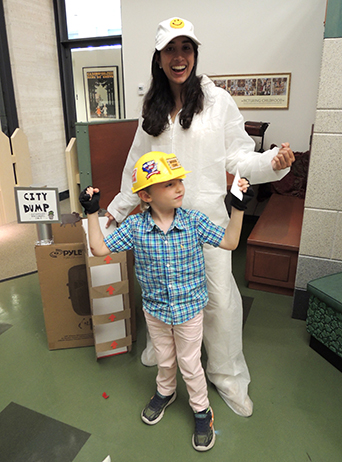
It’s a big job, but our stellar sanitation team is up to the task! Drive your garbage truck to multiple locations around town, then head to the city dump and send everything flying down the chute. Yes we made a mess, but we had SO much fun!
We read Trashy Town, written by Andrea Zimmerman & David Clemesha, illustrated by Dan Yaccarino (HaperCollins, 1999), and read here by Michigan City Public Library. Mr. Gilly is a trash man and wow is he is busy! There are lots of stops all around town (like the school, town park, a pizza parlor) and finally to the city dump to unload. But there’s still one more stop for Mr. Gilly after that…the bathtub!
This was a special final Tiger Tales story time request from a family who was moving out of the area. The story time kiddo asked for “garbage trucks” and “chutes” and we think we delivered!
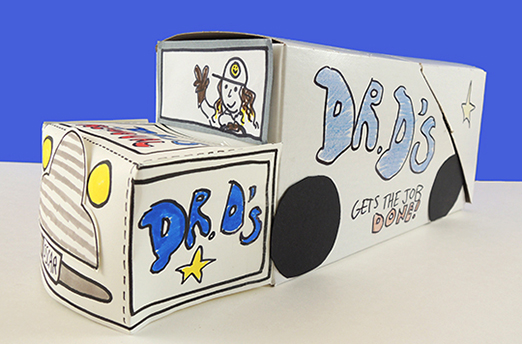 You’ll need:
You’ll need:
- 1 large craft box (ours was 4.5” X 4.5” x 9” but a large tissue box works too!)
- A box cutter
- 1 sparkle stem
- 1 toilet paper tube
- Tin foil
- 1 truck template, printed on 8.5″ x 11″ card stock
- Black construction paper
- Yarn
- Hole punch, scissors and tape for construction
- Markers for decorating
First, the garbage truck! Use a box cutter to make diagonal incisions in the back and bottom of your box, then fold the entire section upwards. This is your garbage truck’s loading hopper. In order to make it easier for kids to raise and lower the hopper, we looped half of a sparkle stem, then taped it to the tailgate.
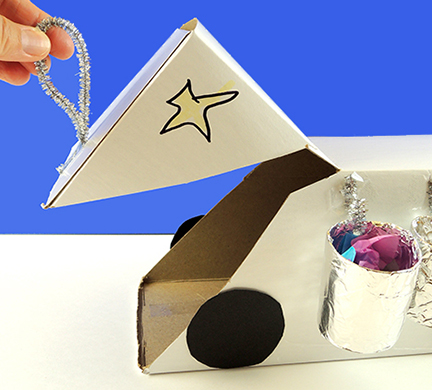
Notice the garbage cans hanging on the side of the truck in the above photo? To make those, cut a toilet paper tube in half, then wrap each in tin foil. Punch a hole in the side of each can and hang them on sparkle stem hooks taped to the side of the truck. We filled our can with scrap tissue paper “garbage” as well.
The front of the truck is a template from this post (just disregard the roof section on the template – or better yet, cut it into little bits and use it to fill your mini garbage cans!). Tape that in place, then add some black construction paper wheels and decorate the truck with markers. Tape a yarn pull string to the front of your truck for hauling.
It’s time to get to work! We constructed models of each of the sites mentioned in the book…school, park, doctor’s office, pizza parlor, fire station, and the city dump. Many thanks to my daughter for helping me construct them (love the smiling pizza slice)!
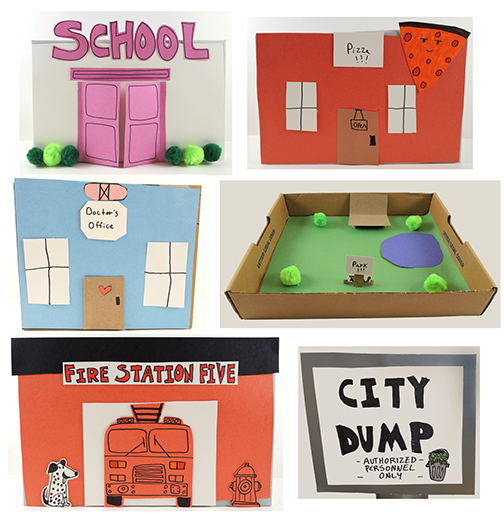 We constructed the buildings and park with shoe boxes and box lids, but the city dump was much larger. It was big box with a removable chute that allowed kids to tip their garbage and send it sliding into the dump. You can see the whole thing here, modeled by our awesome grad student volunteer Shruti Sharma (who was also a cloud scientist at a library event this spring).
We constructed the buildings and park with shoe boxes and box lids, but the city dump was much larger. It was big box with a removable chute that allowed kids to tip their garbage and send it sliding into the dump. You can see the whole thing here, modeled by our awesome grad student volunteer Shruti Sharma (who was also a cloud scientist at a library event this spring).
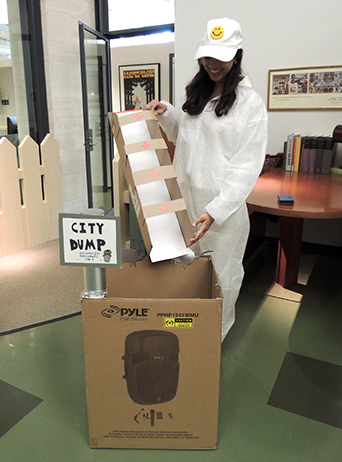 Once every kid had made a truck, they received a “route card” that showed the order in which they needed to visit each place. Since there were 5 sites, I made 5 routes, all different so they story time kids wouldn’t clump together. Each route, of course, ended at the city dump.
Once every kid had made a truck, they received a “route card” that showed the order in which they needed to visit each place. Since there were 5 sites, I made 5 routes, all different so they story time kids wouldn’t clump together. Each route, of course, ended at the city dump.
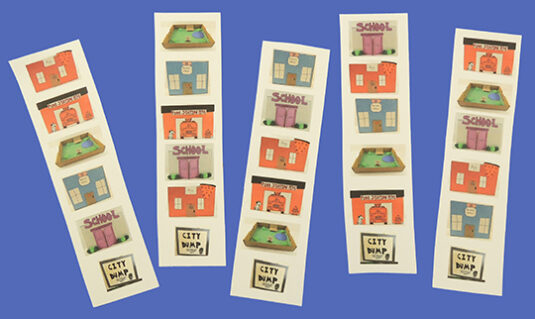 We placed the buildings around the library, and each had it’s own unique “garbage” to be collected. Mostly, these were little do-dads and art supplies from the cabinet. The school’s garbage, for example, are leftover wooden letters from this project. Caregivers and older siblings volunteered to staff each site, refilling “garbage can” cups as each truck rolled up, and the story time garbage kids got to work.
We placed the buildings around the library, and each had it’s own unique “garbage” to be collected. Mostly, these were little do-dads and art supplies from the cabinet. The school’s garbage, for example, are leftover wooden letters from this project. Caregivers and older siblings volunteered to staff each site, refilling “garbage can” cups as each truck rolled up, and the story time garbage kids got to work.
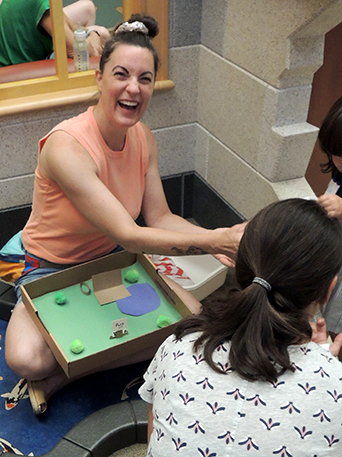 At the city dump, Shruti helped kids slide the garbage down the chute. The back of the big box was cut open, in case kids wanted to take their garbage home. It got a little messy and chaotic. But hey! It IS a dump after all!
At the city dump, Shruti helped kids slide the garbage down the chute. The back of the big box was cut open, in case kids wanted to take their garbage home. It got a little messy and chaotic. But hey! It IS a dump after all!
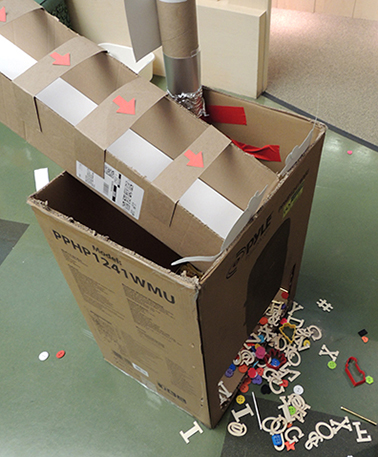 If you would like to do this story time and don’t have time to make the buildings, no worries! Here’s a printable set of the buildings that you can tape to walls and tables. Drive safe, and happy collecting!
If you would like to do this story time and don’t have time to make the buildings, no worries! Here’s a printable set of the buildings that you can tape to walls and tables. Drive safe, and happy collecting!
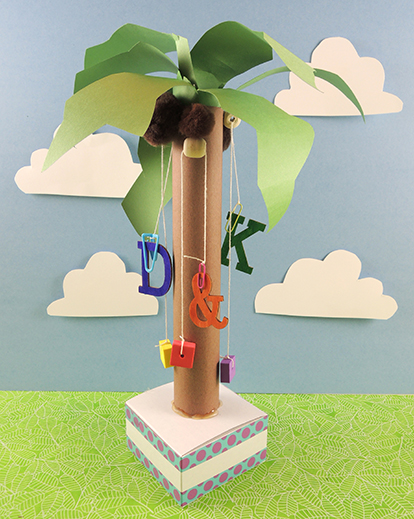 Climb little alphabet, climb! You know those letters, you know that coconut tree, and you know this beloved book. We added a simple dynamic pull string effect to an iconic classic, and the results were boom-tastic!
Climb little alphabet, climb! You know those letters, you know that coconut tree, and you know this beloved book. We added a simple dynamic pull string effect to an iconic classic, and the results were boom-tastic!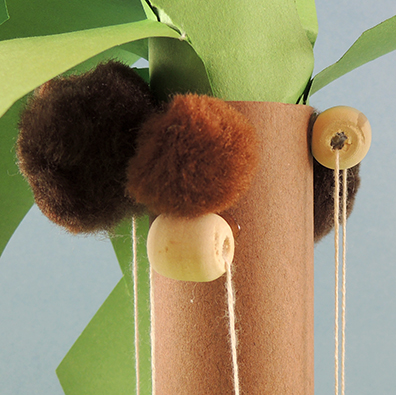 Tie one end of the string to a bead, and the other end to a small paperclip. Next, decorate your letters with markers. We used leftover wood letters from this project, but paper works just as well. Slide the letter onto the paperclip, then pull the bead to watch it climb the tree!
Tie one end of the string to a bead, and the other end to a small paperclip. Next, decorate your letters with markers. We used leftover wood letters from this project, but paper works just as well. Slide the letter onto the paperclip, then pull the bead to watch it climb the tree!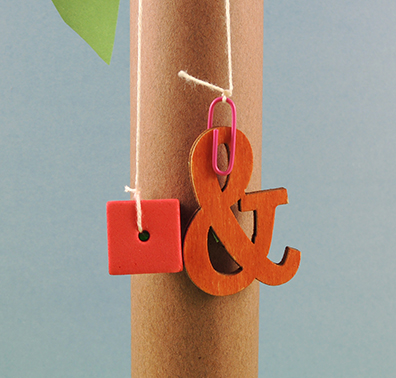 You might ask – why not just permanently tie the letter to the string? You could definitely do that. But we wanted the kids to have multiple interchangeable letters (conveniently stored in the box base of the tree). This way, they can follow along with the story, and send different letters up the tree as they’re mentioned in the story!
You might ask – why not just permanently tie the letter to the string? You could definitely do that. But we wanted the kids to have multiple interchangeable letters (conveniently stored in the box base of the tree). This way, they can follow along with the story, and send different letters up the tree as they’re mentioned in the story!
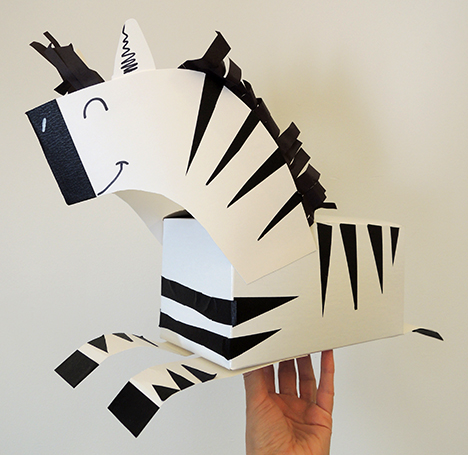
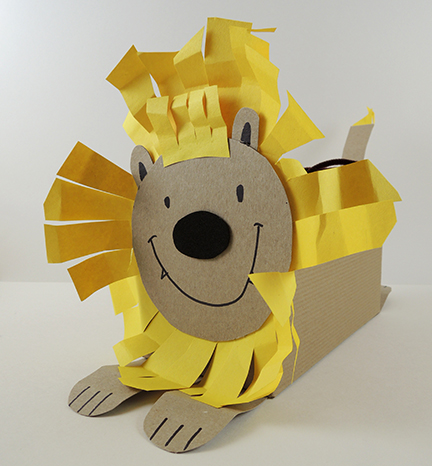 Once the box animals are complete, loop together a pipe cleaner, then tape it to the top of the box, right in the middle. At the top of the loop, either attach a large paperclip to form a hook, or use a carabiner (we had some leftover from
Once the box animals are complete, loop together a pipe cleaner, then tape it to the top of the box, right in the middle. At the top of the loop, either attach a large paperclip to form a hook, or use a carabiner (we had some leftover from 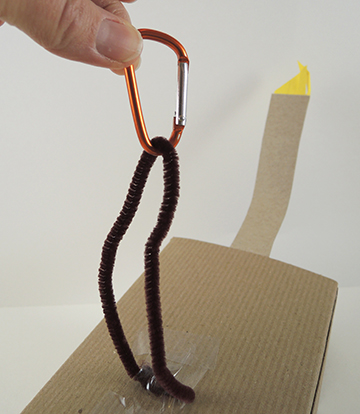 Your animals are ready to race! We set up two zip lines using coated wire. One end of each wire was stabilized on the ceiling of the library, and the other end was held by a volunteer, who could adjust the slope of the zip line to make the box animals go slower or faster. Each kid brought their box animals to the starting line, then scooted over to the finish line (which we marked on the floor with red masking tape). We clipped the boxes to the wire, counted to three, and the race was on!
Your animals are ready to race! We set up two zip lines using coated wire. One end of each wire was stabilized on the ceiling of the library, and the other end was held by a volunteer, who could adjust the slope of the zip line to make the box animals go slower or faster. Each kid brought their box animals to the starting line, then scooted over to the finish line (which we marked on the floor with red masking tape). We clipped the boxes to the wire, counted to three, and the race was on!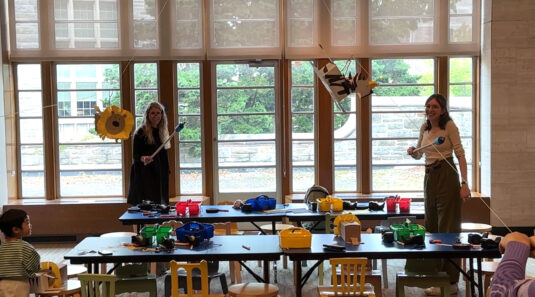
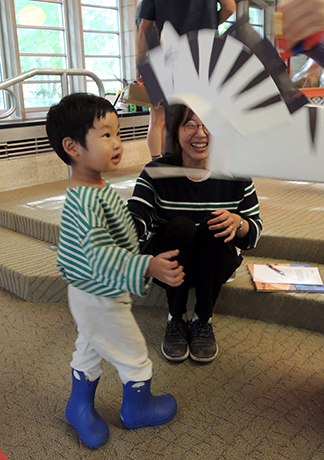

 You’ll need:
You’ll need:
 We constructed the buildings and park with shoe boxes and box lids, but the city dump was much larger. It was big box with a removable chute that allowed kids to tip their garbage and send it sliding into the dump. You can see the whole thing here, modeled by our awesome grad student volunteer Shruti Sharma (who was also a
We constructed the buildings and park with shoe boxes and box lids, but the city dump was much larger. It was big box with a removable chute that allowed kids to tip their garbage and send it sliding into the dump. You can see the whole thing here, modeled by our awesome grad student volunteer Shruti Sharma (who was also a  Once every kid had made a truck, they received a “route card” that showed the order in which they needed to visit each place. Since there were 5 sites, I made 5 routes, all different so they story time kids wouldn’t clump together. Each route, of course, ended at the city dump.
Once every kid had made a truck, they received a “route card” that showed the order in which they needed to visit each place. Since there were 5 sites, I made 5 routes, all different so they story time kids wouldn’t clump together. Each route, of course, ended at the city dump. We placed the buildings around the library, and each had it’s own unique “garbage” to be collected. Mostly, these were little do-dads and art supplies from the cabinet. The school’s garbage, for example, are leftover wooden letters from
We placed the buildings around the library, and each had it’s own unique “garbage” to be collected. Mostly, these were little do-dads and art supplies from the cabinet. The school’s garbage, for example, are leftover wooden letters from  At the city dump, Shruti helped kids slide the garbage down the chute. The back of the big box was cut open, in case kids wanted to take their garbage home. It got a little messy and chaotic. But hey! It IS a dump after all!
At the city dump, Shruti helped kids slide the garbage down the chute. The back of the big box was cut open, in case kids wanted to take their garbage home. It got a little messy and chaotic. But hey! It IS a dump after all! If you would like to do this story time and don’t have time to make the buildings, no worries! Here’s a printable set of the buildings that you can tape to walls and tables. Drive safe, and happy collecting!
If you would like to do this story time and don’t have time to make the buildings, no worries! Here’s a printable set of the buildings that you can tape to walls and tables. Drive safe, and happy collecting!